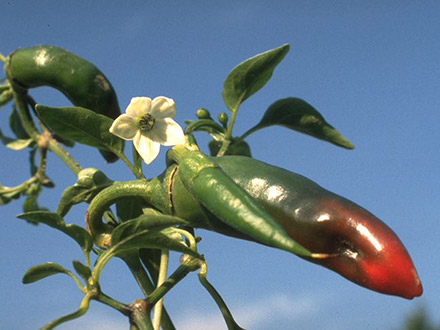Botanical name
Capsicum annuum L. var. minimum (Mill.) Heiser
Family
Nightshade family (Solanaceae)
Common name
Cayenne pepper, Chili pepper
Information about the plant
Cayenne pepper - the name of the plant and the paprika-like red fruits harvested from it - is native to tropical South and Central America, and it is now cultivated across the entire tropical belt of the Earth. It is a perennial, bushy shrub, 0.5 to 1m high, with oval to oval-lanceolate leaves. The flowers are off-white, the fruits are bright red and shiny, and have the typical shape of a pointed cone-shaped pepper - much smaller and less fleshy than bell peppers. Botanically, it is a berry with large, hollow chambers divided by false partitions, so that it resembles a "capsule", which is expressed in the Capsicum genus name (Latin, ‘capsa’ = capsule). The white, round seeds are attached to the internal partitions.
Both the fruit and the seeds are characterized by a hot, burning flavour, hence the name "pepper", which is attributable to the content of capsaicinoids. The fruit of cayenne pepper is therefore used as a strong spice and is the basis for numerous spicy sauces such as Tabasco (Mexico), Sambal Oelek (Indonesia) and the red chili sauce in Chinese cuisine. Selective breeding and hybridization have created a bewildering array of varieties in size, shape, color, and spiciness. This is why there is the addition of "sl" (sensu latiore = in the broader sense) after the botanical name of the plant. In addition to the fruits of C. annuum L. var. minimum, the small-fruited varieties of Capsicum frutescens L. are used for pharmaceutical purposes.
Medicinally used parts of plants (herbal drug)
The dried, ripe fruits (Capsici fructus) are used. They are mainly imported to Europe from tropical countries in Africa.
Constituents of the herbal drug
Cayenne pepper fruits contain hot-tasting capsaicinoids (mostly capsaicin), carotenoids, and flavonoids.
Quality of the drug
The quality of the following drugs or drug preparations is specified in the European Pharmacopoeia (Ph. Eur):
- Cayenne pepper (Capsici fructus)
- Capsicum oleoresin, refined and standardized (Capsici oleoresina raffinata et normata)
- Capsicum tincture, standardized (capsici tinctura normata)
- Capsicum sift extract, standardized (Capsici extractum spissum normatum)
Medical applications
Recognised medical use
The HMPC has accepted the external use of cayenne pepper for the relief of muscle pain in the lower back (back pain) as "well-established use".
ESCOP: externally for the relief of muscle pain, e.g. back pain, and for the treatment of pain in degenerative joint disease (osteoarthritis) and rheumatoid arthritis; also for the treatment of nerve pain, e.g. as a result of psoriasis or in painful diabetic neuropathy; also against pruritus of various etiologies, e.g. in connection with psoriasis or blood dialysis, and in contact with water.
Traditional use
Cayenne pepper has no listing for traditional medicinal use.
Herbal drug preparations in finished dosage forms
- Thick extract standardized to capsaicinoids in creams
- Alcoholic extracts standardized to capsaicinoids in ointments and heat plasters
Dosage
Prepared drugs: see patient information leaflet.
Tea: as cayenne pepper is only used externally, a tea is not indicated.
Preparation of a tea
Not applicable.
Notes
Cayenne pepper preparations should not be applied to damaged skin or mucous membranes.
Contact with the eyes must be avoided completely. Therefore, hands must be washed carefully with soap after using cayenne pepper preparations. If possible, gloves should be used during application.
No safety studies are available on the use of cayenne pepper during pregnancy and lactation. Children and adolescents under the age of 18 should not use cayenne pepper.
Side effects
When using cayenne pepper for treatment, there are different signs of the effect: burning, heat generation, and inflammatory redness of the skin, which disappears after the treatment. These side effects usually diminish with frequent use.
Interactions
Cayenne pepper preparations should not be used in combination with other medicines for external application.
References
Herbal drug monographs
HMPC (2015, 2023), ESCOP (2009)
Further literature
Commentary on the European Pharmacopoeia (Cayenne pepper, No. 1859; Cayenne pepper oil resin, No. 2336; Cayenne pepper thick extract, No. 2529; Cayenne pepper tincture, No. 2337)


